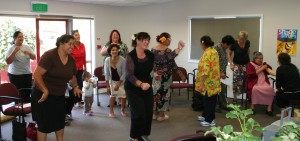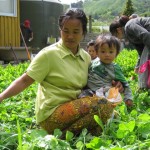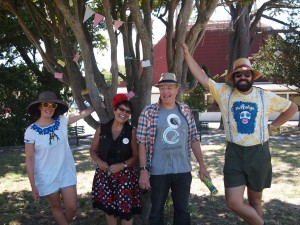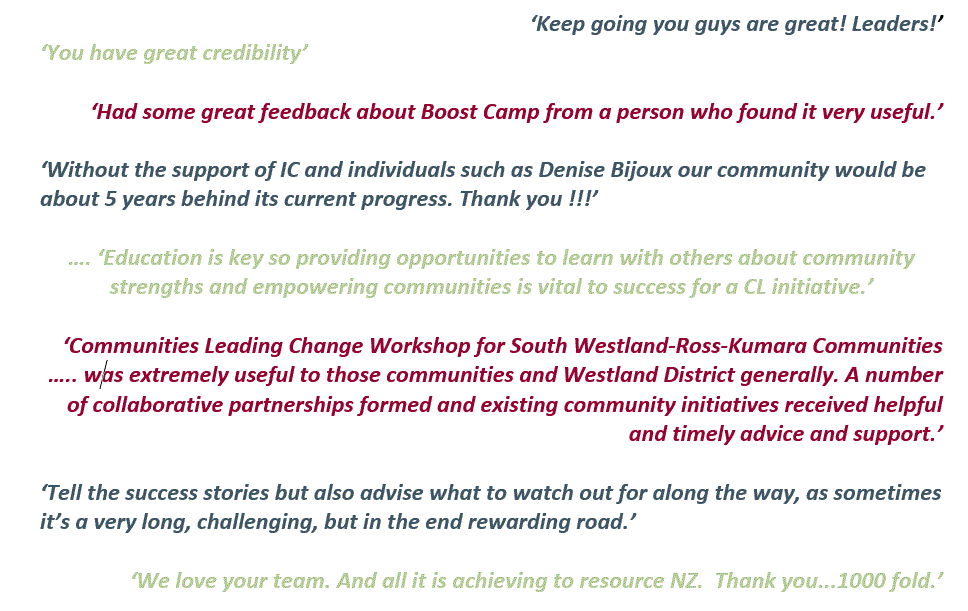Cherry Chaos Creates Connections
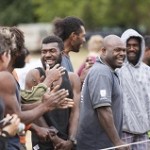 What better way to welcome people into a community than with a huge food fight challenge? Well that’s what we do in Roxburgh, Central Otago.
What better way to welcome people into a community than with a huge food fight challenge? Well that’s what we do in Roxburgh, Central Otago.
During summer the population of Roxburgh (usually about 500) explodes with hundreds of seasonal workers arriving from all over the world to work in the orchards. Seasonal workers are an important part of the community and the local economy, and it is important that they feel welcome, valued and connected.
Arriving in a new place can be a challenge, particularly when you’re living and working in a different country and a different culture. Local community group, Teviot Prospects, wanted to come up with a way to welcome their international workers and give them an opportunity to connect with locals and other like-minded visitors.
They wanted to develop a fun and engaging event to get as many people to take part as possible. It needed to be something that visitors and locals could join in together in a relaxed environment to build connections and have some fun.
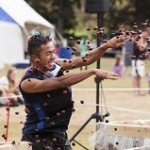 The idea of a food fight challenge was floated…and Cherry Chaos was born. It was perfect – a celebration of the fruit harvest and a fun event for the whole community to enjoy!
The idea of a food fight challenge was floated…and Cherry Chaos was born. It was perfect – a celebration of the fruit harvest and a fun event for the whole community to enjoy!
Lots of work went into developing the concept, planning the event, and finding equipment and produce. Members of the group worked hard to make sure the event went off without a hitch, health and safety requirements were met, volunteers organised and the event promoted to the masses.
Local orchardists were hugely supportive providing the fruit, sponsoring teams and giving their workers time off to compete. The produce used for the event was only suitable for stock food and not fit for human consumption. They were simply intercepted for a day of fun and then put back into the food chain.
Cherry Chaos – obstacle course
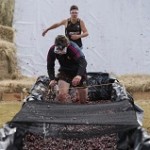 For the main event teams of six people completed an obstacle course against the clock, while opposing teams pelted them with cherries. Scaling walls (while slipping on cherries), crawling under nets (through squelchy cherries), pushing teammates in wheelbarrows (being pelted with cherries) and navigating drums and crates full of messy cherries was all part of the chaos. And the result? A hugely entertaining mess of cherries with everyone having a fabulous time – competitors and spectators alike.
For the main event teams of six people completed an obstacle course against the clock, while opposing teams pelted them with cherries. Scaling walls (while slipping on cherries), crawling under nets (through squelchy cherries), pushing teammates in wheelbarrows (being pelted with cherries) and navigating drums and crates full of messy cherries was all part of the chaos. And the result? A hugely entertaining mess of cherries with everyone having a fabulous time – competitors and spectators alike.
Competitors said, “we’re having a blast”, “it’s so much fun”, and the sheer joy on their faces confirmed it.
Something for everyone
Getting in a cherry mess is not everybody’s cup of tea, so those who didn’t want to ‘run the gauntlet’ were able to take part in a number of other activities, or simply watch on and enjoy the atmosphere. Stalls provided refreshments and hot food, and a local band entertained the crowd with live music.
‘Slingshot Hit the Spot’ and a horizontal bungy were fun activities for younger people to take part in. A Cherry Cooking competition with ‘cherrylicious’ categories of pies, cakes and condiments saw many delicious creations entered and was very popular with both entrants and judges!
The entire event was such a success that Teviot Prospects are planning for it to be an annual fixture in the area’s event calendar – and who knows, next year could be even bigger and better!
By Genevieve Heal, Community Services Projects Officer at Central Otago District Council
http://www.centralotagonz.com/community-development
Being in – and of – service vs providing services
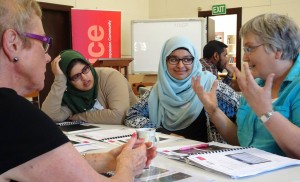 Faith based organisations around the world are at the forefront of community-led development momentum, including here in Aotearoa. Community-led development resonates because it helps to expand established practices of ‘pastoral care’ to include a broader spectrum of tools that can naturally nurture the heart and soul of the community, writes IC’s Denise Bijoux.
Faith based organisations around the world are at the forefront of community-led development momentum, including here in Aotearoa. Community-led development resonates because it helps to expand established practices of ‘pastoral care’ to include a broader spectrum of tools that can naturally nurture the heart and soul of the community, writes IC’s Denise Bijoux.
Many such organisations and groups have, of course, worked with their communities towards better lives for many years but there is a conscious returning to ancient roots where being hands on champions of social justice and peace making is once again at the heart.
During his recent visit to New Zealand Jim Diers and I ran three workshops co-hosted with faith organisations. We shared and practiced key concepts and tools for community building and community action and together, we worked out some integral roles faith communities can take in growing local community beyond their church communities. It’s about being in and of service to those around us, much more than it is about providing services. This means working with the priorities and energies of our neighbours and local communities, and at their pace too.
Two of these workshops were in Auckland, and one in Dunedin. Here’s some insights from three Auckland participants.
The Courage workshop in Auckland was co-hosted by John MacDonald, Superintendent at Methodist Mission Northern, and a leader of Splice – a movement of people connecting in Auckland’s City Centre.
Splice happened when, in 2012, two inner city church communities decided to re-focus their mission in Auckland’s central business district. Acting together, the congregations of the Aotea Methodist Chapel and St James Presbyterian Church agreed to support a new role. Other partners also joined the evolving enterprise: the Auckland Methodist Synod, the Northern Presbytery of the Presbyterian Church, and Methodist Mission Northern, which also provides project oversight. Already that way things were being done was different.
John was hired as the chaplain at large and spent the first couple of months immersed in the city to get to know the people. By listening to and working with many people, Splice has evolved and works in ways that are well beyond traditional church practices of pastoral care. At times this challenges the “religious status quo” and demands closer relationships and better understandings among community builders of all kinds.
“Our message, and who we are, needs to be real, alive and effective. We need words and images that invite a range of people to engage in creating something new together. The presence of poets, storytellers, dramatists, artists, skilled professionals and other diverse participants will enable us to put words and images together in a way that encourages people to pause and consider what it means to be courageous, compassionate and community in downtown Auckland. The success of whatever ‘mission’ emerges will depend in part on our willingness to ‘do complexity’ rather than avoid it, and to engage our imaginations.”
John saw the Courage workshop as not only a way of bringing diverse people together (different faiths, business people, artists, activists, community development workers and more) – and therefore being a tool to grow interconnection beyond the host church and faith organisations in and of itself – but also as a way of sharing and acting together using tools new to many of the participants.
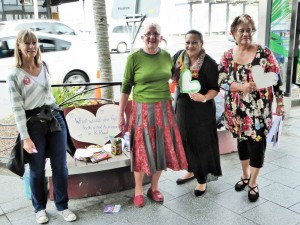 “Courage showed us that we are not as far apart as we might think we are. That with some courage, communication and innovative techniques, we can find many common goals across our very diverse neighbours here on Karangahape Road and by knowing this we can be a better neighbour ourselves; we can grow community in ways that work for us all who are here in this place right now. This will help sustain what is valued here and grow the things we want more of.
“Courage showed us that we are not as far apart as we might think we are. That with some courage, communication and innovative techniques, we can find many common goals across our very diverse neighbours here on Karangahape Road and by knowing this we can be a better neighbour ourselves; we can grow community in ways that work for us all who are here in this place right now. This will help sustain what is valued here and grow the things we want more of.
Courage showed us how to work with and build on what we already have. It helped us learn, develop and practice tools and techniques that promote divergent thinking and lead us into action. And this is what SPLICE seeks in order to activate determined and shared leadership that is committed to establishing innovative and sustainable initiatives. Going forward we need to ensure that developments do not rely on any individual’s leadership or presence, but rather encourage many people to work together and exercise various forms of leadership, sometimes at the same time. Being in service means not only valuing wider perspectives but joining with them and creating many different pathways and solutions together. Learning by doing.”
Aarif Rasheed is a NZ-born Fijian Muslim. He is a community lawyer, mediator and facilitator who set up JustCommunity. He attended the Courage workshop so he could “make more sense of how” his work creating meaningful connections and conversations between diverse faith communities could be enhanced in a way that allows people to self-advocate.
“Minority communities are often the most disillusioned with their leadership because of the frequency of leaders being compromised across the diversity of often conflicting interests”, he says, “This disconnection with leadership further reduces the already minimal engagement minority communities are able to have with the wider community. CLD allows us to give unheard people in the politics of diversity a real and empowered voice which requires a truly bottom up approach”.
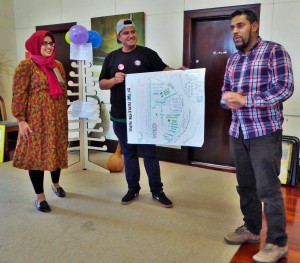 For Aarif, the Courage workshop offered many different and practical ways of creating connections across and within groups. For example, he sees CLD as “connecting hearts and minds rather than structures and documents. It also helps remove the privilege that can exist within communities as a result of perceived legalities and bureaucratic know-how. This enables the richness of cultural and faith tradition to be included in community change and, say, the refugee grandmother to play a greater role than community organisations often allow.”
For Aarif, the Courage workshop offered many different and practical ways of creating connections across and within groups. For example, he sees CLD as “connecting hearts and minds rather than structures and documents. It also helps remove the privilege that can exist within communities as a result of perceived legalities and bureaucratic know-how. This enables the richness of cultural and faith tradition to be included in community change and, say, the refugee grandmother to play a greater role than community organisations often allow.”
In this context, CLD is as much political as it is practical. Courage and new techniques are both required, and the impact of the workshop is already having a far reaching impact.
“My current work presently seeks to employ CLD methods to impart the richness of religious and cultural tradition and wisdom in the current disconnected individualist environment that has developed a phobia for tradition out of for example Islam’s identity crisis. In doing so I also connect leaders from more mature diverse communities like Sydney and South Africa.
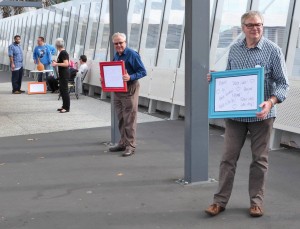 CLD will allow me to take the accumulation of these connections and conversations back to local communities to decide their own needs, in accordance with their complex geo-political identities, to join who they want, how they want, and to what end. The opportunities are limitless! I look forward to introducing more people to not just the concept but the techniques of CLD, to make these words a reality in the coming 5-10 years”.
CLD will allow me to take the accumulation of these connections and conversations back to local communities to decide their own needs, in accordance with their complex geo-political identities, to join who they want, how they want, and to what end. The opportunities are limitless! I look forward to introducing more people to not just the concept but the techniques of CLD, to make these words a reality in the coming 5-10 years”.
Also looking to make CLD a reality in both process and outcome is another Courage workshop participant, Reverend Peter Norman. He is Superintendent at the Northcote Takapuna Methodist Parish and also hosted a shorter workshop with Jim and I after the Courage event. Peter agrees that developing strong, resilient and active communities can come, in part, from a recognition that faith based groups can have key roles to play in community led development. Faith groups can have access to assets, talents and resources the wider community may not have and by activating these in ways that are in service to the visions of local people, faith groups can contribute to deeper community connections, cohesion and capital.
“The growing diversity and constantly changing demographic has highlighted the need to move away from insular thinking and break down the four walls. For Takapuna Methodist Church this has meant reassessing our raison d’etre. Out of this reassessment came a vision for Compassionate, Creative, Connected Communities and a desire to find meaning and purpose in working with and for others. However, in order to do this a deeper more meaningful engagement with the community was required. One of the things we have done to achieve this is form a partnership with Auckland North Community and Development and Lifewise. This ‘Shore to Thrive’ project has employed a Community Development Coordinator and has also spurred us to create ‘Community Matters’, a group to help us develop our community focus.
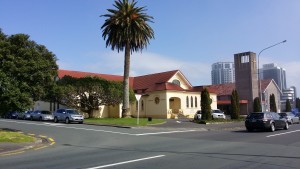 Peter is based at the Takapuna Methodist Church which has a long history in community development and was where Neighbours Day Aotearoa began. Just a few weeks after the workshops with us, they are incorporating new strategies in both their long and shorter term planning; Working with what they have already have and starting with a welcoming entranceway. What a great place to begin!
Peter is based at the Takapuna Methodist Church which has a long history in community development and was where Neighbours Day Aotearoa began. Just a few weeks after the workshops with us, they are incorporating new strategies in both their long and shorter term planning; Working with what they have already have and starting with a welcoming entranceway. What a great place to begin!
Jim Diers is back in Aotearoa in September 2016 and March 2017. Both tours are already filling quickly so please email Denise to find out more about working with Jim in your place, or to inquire about hosting a 2 day training workshop like ‘Courage’. More information on practice workshops with Jim and Denise in and with local communities will be available soon. denise.bijoux@inspiringcommunities.org.nz
Visit Just Community-NZ facebook page
Read more about the Northcote Takapuna Methodist Parish
Sustaining Victory
30th May, 2016
I’ve been Director at Victory Community Centre for 8 years now, since our inception and the almost 3 years leading to it being here.Over time we’ve transformed ourselves into a thriving community where people feel connected to a wide range of services and support, especially our own Be Well Community Nurse Penny, a programme of fun, social and recreational opportunities, and we’ve established a community garden with support from DHB and their Nutrition and Physical Activity Plan. We have adapted the projects and initiatives to ensure that we can sustain the momentum.
Some days the work does generate the feelings “how do we keep going, when it feels we are swimming against the tide with funding”, and “are we really making any difference?” So what has and does sustain our organisation, our CSO (Civil Society Organisation)?
We have been blessed by having really stable, highly professional staff with an appreciation of the strategic relationships to support the vision and mission of Victory Village as well as genuine and high capacity for the day to day realities – i.e. not afraid to muck in with whatever it takes. This staffing quality and stability has enabled continuity of care and a sense of genuine relationship building.
Our first three employees have been here for the duration – we are now a team of five part-timers. Recruitment and retention is a big factor in sustainability. The approach I take as Director is closely supported by a particular philosophical approach with managing the centre. I actively work in terms of staff with the SCARF model. Short version of this model: It articulates our social needs at work, which I believe if met, contribute to stability and sustainability of the staff. SCARF stands for Status; Certainty; Autonomy; Relatedness; Fairness. (Check it out in more detail here.) If we actively discuss ways to meet these needs, and structure the job descriptions and systems of our work, and our ways of working as individuals and teams accordingly, then these needs will be met.
The second big factor for sustainability is financial stability. I use what is called the “6 -7 Key Streams” model. I learned this from Kerri Tilby-Price at an Exult workshop. As a financial manager, all income is coded into 6 or 7 streams (the 7th is membership, and some organisations don’t work on that basis). I code all income and expenditure so that we can track where and what, comes and goes. Using that as a percentage of all income, it becomes visible where the potential lies to bring better balance into all the streams. Relatively simple, and yet very effective from my experience and creates some clear targets and focus for activity in our organisation.
I am keenly aware that the third main contributor to sustainability is about relationships. A colleague once said “The currency of business is money and profit. The currency of CSO’s is relationship”. Every relationship we have, whether it’s to support us, or for us to support others, contributes to our vision and mission. And every one of them falls into all or part of the continuum:
Partnership – Collaboration – Cooperation – Networking – Co-existence
With some organisations, like our relationship to the school here, we actively work across the whole continuum. Being clear on where on the continuum this piece of work is occurring helps establish the nature of the relationship. It may be that you want to move a relationship from networking, to becoming partners. What will help that happen, and why, are good things to clarify before you invest time and energy.
The last factor that I believe contributes to sustaining momentum is being open to opportunities. Being welcoming, warm, nimble and accessible to people and their contributions, can be game changers on a day. Being willing in the moment to say “YES” to offers of support or connection, and then figuring out the “how and when” is generally our first response. So being willing to take a manageable risk given your experience and intuitive sense of how much you can trust a new relationship or connection, can take your organisation into new and exciting opportunities that we might not have considered. This generates creativity, and possibility and keeps hope alive.
By Kindra Douglas
There’s a lot more about Victory Village at the following links:
Watch Kindra talk about the SCARF model in the 3rd module of our At the Heart Resources.
Our Door is Always Open – At The Heart Module 4 video.
A collection of information from the 2011 Victory Village Forum.
A light touch – firm results
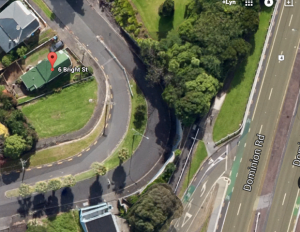 From the side-lines we watched a piece of unused council land in Central Auckland transform into a garden that would encourage pollinators like butterflies and bees. One woman with a small idea working alone – until the neighbours noticed and got involved
From the side-lines we watched a piece of unused council land in Central Auckland transform into a garden that would encourage pollinators like butterflies and bees. One woman with a small idea working alone – until the neighbours noticed and got involved
While tending the garden they began to talk about the wall and tunnel opposite which were tagged and a magnet for dubious activity.
A small group decided to organise a competition to put a mural up on the wall. A local artist was announced the winner. But then funding was required, and gathering that was taking a while which is when Inspiring Communities became involved.
We helped strategise, we acted as social brokers, putting them in touch with the right people, giving them language and approaches to use. We helped them figure out how to plug into others in the community to ensure they were building on the existing strengths.
We provided a sounding board and ideas to help fundraise and get local businesses involved. We suggested they approach Council to contribute once local support and resourcing w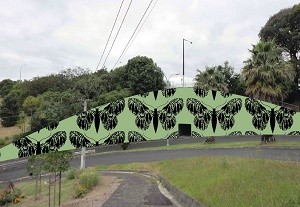 as secured and gave them advice about keeping local people engaged.
as secured and gave them advice about keeping local people engaged.
We then took a lead role in promoting progress on the painting and in organising a Neighbours Day celebration to thank neighbours.
This process and resulting mural have given the Eden Terrace community a sense of pride and security. It’s also led to re-vegetating the small reserve above the tunnel and there is talk of other events and enterprises to help pay for maintenance and upkeep of the mural, garden and reserve.
‘No Place Like Home’ Treasure Hunt
By Sue Jenkins
On Saturday 13th February Newtown was home to a very special kind of Treasure Hunt, revealing, to residents and visitors alike, some hidden treasures lying at the heart of the community.
A beautiful, sunny, Wellington afternoon and children and adults assembled at the Newtown Community and Cultural Centre to register for the event; picking up a map with essential clues and preparing for a fun day out! Many of the participants had risen to the challenge of donning fancy dress costume for the occasion.
Along the route there were many ‘have-a-go activities’ such as: energetic hula-hooping at the Wellington Circus Trust, learning a new dance move at the NZ School of Dance, and the slightly more sedate, but very creative, art-workshop pasta-style at Cicio Cacio Osteria. Some particularly talented youngsters were observed giving it their best shot and certainly enjoying themselves into the bargain.
The Treasure Hunt introduced participants to some of Newtown’s older historical sites such as the older Fever Hospital now the how to the SPCA. They were introduced to the world behind the rising stars of Toi Whakaari and New Zealand School of Dance and tickled their taste buds with a new cold nitro brew at the People’s Coffee Roastery. Whether it was a visit to the Carrara Park Community Gardens or a sneak peek at Te Kaahui Kohanga Reo, there was certainly something for everyone.
And a lovely idea at St Anne’s Place of Peace, where the wishing tree could be found. Here, everyone was invited to write down their wish and hang it on the wishing tree. From the very understandable wish for ‘a special pet’ to an extremely poignant wish for ‘the bullies to stop,’ everybody had a chance to express their heartfelt wishes in that lovely, quiet spot.
The afternoon was rounded off with a free BBQ at Newtown Workingman’s Bowling club and a live performance by Sendam Rawkustra.
The aim of the treasure hunt was to create a sense of adventure in people’s backyard. As people journeyed through the different activity stations they would continue to bump into each other and share their stories and experiences. The BBQ afterwards provided a space where these informal relationships could be continued still within the space of the event. Hopefully a longer term impact will be that they will share a smile or a hello next time they pass each other in the street.
Everyone learnt something new about ‘this place called home,’ during a very well organised and adventurous afternoon. A well-deserved vote of thanks goes to the many people volunteering their time to ensure that the event ran smoothly and maintained a high level of safety. Radiant smiles on the faces of the people positioned at each of the stations along the route and encouraging comments from those assisting with road-crossing helped the participants! A newcomer to Newtown, I certainly enjoyed the tremendous sense of community.
This event wouldn’t have been possible without the Sponsors, including Newtown New World and Commonsense Organics, WCC & Thank you Charitable Trust.
To find out more about how to organise a community treasure hunt – go to http://site.ouramazingplace.org.nz
IC Survey results demonstrate the Influence of IC and CLD
Inspiring Communities has been very influential in changing the thinking about community-led development and being a conduit to innovative ideas and Kiwi practice wisdom.
Survey respondent
Inspiring Communities November survey shows that IC and CLD are highly valued by respondents.
We are encouraged to see our newsletter, hosting international speakers, the resources we produce and the research we share as well as influencing others, our public policy work and Boost Camp all rated highly.
About 2/3 say that Inspiring Communities has contributed to the growing profile and awareness of CLD in NZ and almost 60% say CLD learning tools, stories and tips from Inspiring Communities have helped them in their roles. Over 70% of respondents highly regard our summaries and the ‘how to’s’ of CLD techniques and workshops based on Learning by Doing Chapters.
Comments suggest that Inspiring Communities could make these chapters even more useful by contextualising them via workshops and other presentations as well as sharing via Facebook, Skype and video as these are the most regularly used electronic tools.
Respondents also believe there is more work to be done in educating associated sectors. While definitive that CLD is a game changer, there is concern at a lack of understanding of its true value.
- Community-led development is important part of NZ’s future (85.17%)
- There is a need to strengthen community-leadership in NZ (83.90%)
- Local communities really understand their role in supporting local businesses (29.24%)
- Local businesses really understand their role in supporting local communities (23.73%)
- There is a good understanding of CLD within local government (23.30%)
- There is a good understanding of CLD within central government (17.80%)
The team is currently considering the opportunities raised in the survey. The series of training and events outlined later in this newsletter are just some of these initiatives.
Unfortunately there was a technical problem in collating contact details. We have been unable to get in touch with people who signalled an interest in working with us. If you did we would appreciate you contacting us at exchange@inspiringcommunities.org.nz and we will follow up.
Again we would like to thank everyone who took the time to complete this survey, it has certainly given us plenty of valuable information.
Building Business Connections over Breakfast
By Anna Larsen, Manager, Welcome Bay Community Centre Inc
The Community Centre in Welcome Bay is in the heart of a unique Tauranga suburb. Welcome Bay’s nearly 18 thousand people make up 1/6th of Tauranga’s population, yet it has very little social infrastructure and virtually no employment opportunities. The suburb acts as a dormitory, with most people in paid employment, and all school students over 11 commuting out of the suburb daily. Teaching is the main occupation in Welcome Bay – we have four primary schools, two state kindergartens and a number of Early Childhood Education centres. There is no public library, very few recreational facilities, and no supermarket. There is very little within the community that traps money in a local economy.
But there IS a strong core of home-based self-employed businesses, and without casting our net very wide, we discovered that when it comes to practical skills, you don’t need to go far to cover most of the trades. Our community should be able to meet most of our business needs without going outside of the local business sector. The missing link is that we don’t know each other, yet one of the greatest users of business is business!
The Welcome Bay Community Centre has been actively engaging with business people over the past couple of years through the establishment of a Business Network. It’s been a slow process, but the local business community has been keen to engage with the wider community.
We held a Business Network Breakfast in January 2014. The Tauranga City Council’s Chief Executive, who was new to the city as well as his job then, was our guest speaker. His presentation in front of a packed room generated some wonderful conversation focussed on the local community, and gave him some grunty food for thought to chew on. Subsequent breakfasts featuring the Tauranga Chamber of Commerce’s Chief Executive and our local MP have also been a great success. We also encourage breakfast network participants to bring their business opportunities to the wider local community.
Our next step is to invite them to support a local quarterly publication that will appeal to the community with relevant editorial content, interesting articles, informative columns and a directory of the local businesses. We’re keen to make sure our local business people are connected to each other and to our local people. It’s part of generating a sense of belonging and engagement in our great place.
More info:
email: centremanager@welcomebayorg.nz
Visit: www.welcomebay.org.nz
https://www.facebook.com/WelcomeBayCommunityCentre?ref=hl
Eketahuna – It’s a long way from the city
By Bridget Wellwood , Chair of both the Eketahuna Our Town Committee and the Eketahuna / Mellemskov Museum
How does a small town, famous for being in the middle of nowhere in particular (Eketa-where?) hope to survive in today’s economic climate?
We are up against it – unemployment, low socio-economic stats, unstable dairy prices, a reputation for rainfall, for starters.
With only 450 people living in town and over half of those people earning less than $20,000 pa, the challenge of economic development seems unobtainable.
Yet Eketahuna residents are working together to find local solutions, to push the boundaries, and to draw people closer.
We are a resilient community and out of adversity Eketahuna has always bounced back. After the petrol station burned down, we responded by floating debentures (seeking the support of the local farming district as well) to rebuild a new station, now leased by local operators but still owned by the community (Eketahuna Charitable Trust). People said it couldn’t be done – but the business is flourishing.
Similarly the local grocery store faced closure – debentures were offered and it is now a thriving Four Square leased, but jointly owned, by the Eketahuna Charitable Trust and Masterton’s Trust House. It is the hub for the community.
There are too many community organisations to list, people here want to make a difference. If something doesn’t exist we roll up our sleeves. For example the local Youth Trust want a Skate Park – these kids are out fundraising, and are being well supported by the community (and funders) for their initiative.
We have a library, a good health centre, primary school, swimming pool, op-shop, police, ambulance and fire services amongst our locally run services.
Eketahuna has always been a stop off point. Today people stop for the (newly upgraded) loos and petrol, as well as for the fabulous coffee shops and boutique design and interiors shops that are now open, or to explore some of the lesser known attractions – the Cliff Walk, the local art gallery, or a round of golf.
The Eketahuna Our Town Committee wants to capitalise on possibl e tourism benefits so we are undertaking a number of projects, such as mapping routes to take advantage of the growth in recreational biking, The Eketahuna / Mellemskov Museum is re-inventing itself, becoming more interactive with the community and hosting pop-up exhibitions.
e tourism benefits so we are undertaking a number of projects, such as mapping routes to take advantage of the growth in recreational biking, The Eketahuna / Mellemskov Museum is re-inventing itself, becoming more interactive with the community and hosting pop-up exhibitions.
And the newly developed Eketahuna Railway Station – a collaborative community project to reinstate a small station – is a huge success bringing people here on steam train day excursions.
We have also become event focused running a variety of historical, medieval and art expos over a number of weekends throughout the year.
Self-employment is a good option here and people are thinking hard about social enterprise and collaborations as an effective means to reduce overheads – working together in shared workspaces makes good sense.
We are rebranding the Eketahuna experience getting beyond people’s perceptions that we might be a backward place to some new quality tourism products. Small we may be but that certainly doesn’t equate to our vision of how things might be in our future.
Thriving incubators of leadership in communities
By Chris Jansen
We have experienced an extreme range of experience since the earthquakes that rocked Greater Christchurch ,from fear, loss, frustration and anger on one hand, while on the other hand an immense and surprising renaissance of grass-roots community connections, initiatives and innovation.
Mangakino – community of choice!
It’s little wonder that this small central North Island community has featured so positively in recent national media. With a population of around 1,000 spread across the rural area and in townships of Whakamaru and Mangakino, the people there are ‘going for it’ to build local community spirit, vibrancy and achievement.
Economic development is one thrust of their effort. Attracting more visitors, and creating more for them to do locally is a community focus. New highway and local signage now ensures road users know the townships are there, and the wealth of activities available. Cafes and eateries (one established by a local young woman only opened one year ago) are very busy and provide more work opportunities. They’ve also created their own Info Site – ‘that Dam Info Caravan’ which can be towed across the country promoting Mangakino and Whakamaru, and providing a base for locals at events.
There’s a growing focus on making sure local people know about what jobs are coming up, and aware of the skills and training they need. There are community systems in place to help locals, especially young people, get into training and complete relevant courses so their options for work grow, along with their confidence. Thirty people from the area received certificates at the recent Industry Training Organisation Awards Ceremony for 2015. And the community are supporting groups of people to travel to work out of town, an impossibility for individuals one by one.
This summer Mangakino and Whakamaru will launch the first boards of a new Heritage Trail celebrating local history, and providing both townfolk and visitors another activity to enjoy, perhaps in association with cycling or walking the Waikato River Trails which pass through the area. Local retail sales are up, the visitor spend is up, and Mangakino has enjoyed an increase of 35.4% in spending based on the same period last year – to the value $678,976 (figures from the MarketView Quarterly Report to September 2015 for Taupō District Council).
Since establishment of the towns in the mid 1900s to build the hydro dams, they’ve been known as family friendly places. Both current residents and bach owners treasure that it feels safe to let tamariki and children walk to the shops or to the new skatepark that young people helped design and fundraise for. And there are a growing number of community-run events, and participation, including the annual raft race and Easter Sunday Services and picnics. This year float numbers in the annual Christmas Parade have trebled! There’s a Community Calendar, website and Facebook page to keep people connected, a local weekly news-sheet and regular emails to the non-resident ratepayer database to keep those with a stake in Mangakino informed and connected. The volunteer base is growing at a rate not known for years, especially for the essential local Fire and Ambulance services, but also for the senior citizen activities and local social and youth services.
So what’s the magic at work here? We think it’s about a community growing its own capability and confidence to work together more to achieve their own local visions. Progress has been enabled by the willingess of local employers and businesses, local health and social services, the marae, residents, the schools and whanau services, and the local Council to ‘take off their individual agency hats’ and find new ways to contribute their assets and strengths in the interests of transforming their community. A government agency has contributed some resourcing, and shown willingness to learn to work in new ways itself to help enable this change over a four year period.
The community has invested in some “glue” – co-ordination and brokering to help create some new systems that support sharing information and working together more. They have taken time to learn new ideas and skills. Their evaluation approach takes a focus on what’s precious and what’s changing among people and organisations, and whether they are ‘moving the dial’ on working together more. They realise that it’s not just the individual projects that matter, it’s the strength of ties locally, and the shared local vision, commitment and capacity to work together that will endure.
Inspiring Communities reflects that this is long-term work for a community. National and international evidence suggests it takes a decade for communities to embed new ways of working together. It spotlights the importance of integrated policies and funding flows, and a comprehensive and multi-year approach.
The Department of Internal Affairs has contributed some resourcing, and shown willingness to learn to work in new ways itself to help enable this change over a four year period.
For more information see www.mangakino.net.nz
More information on their heritage trail created in 2016.

